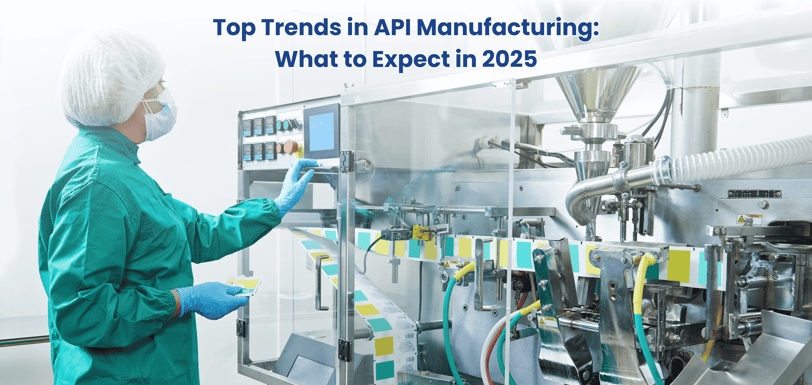Top Trends in API Manufacturing: What to Expect in 2025
The pharmaceutical industry is rapidly evolving, and the manufacturing of Active Pharmaceutical Ingredients (APIs) is no exception. As we approach 2025, several trends are poised to redefine how APIs are developed, produced, and delivered. Here’s a closer look at the top trends shaping the future of API manufacturing.
1/29/20252 min read


1. Sustainability and Green Chemistry
Environmental concerns are becoming a priority for pharmaceutical companies, pushing the industry toward more sustainable practices. Green chemistry principles, such as minimizing waste and using renewable raw materials, are being adopted to reduce the environmental footprint of API production. By 2025, expect widespread integration of eco-friendly processes, such as:
Biocatalysis for cleaner reactions.
Adoption of solvent recovery and recycling systems.
Use of energy-efficient technologies to reduce carbon emissions.
2. Continuous Manufacturing
Continuous manufacturing (CM) is transforming the production landscape by replacing traditional batch processes. This method allows for seamless, uninterrupted production, offering benefits such as improved quality, reduced costs, and faster time-to-market. Regulatory agencies, including the FDA, are increasingly supporting CM adoption, making it a cornerstone of API manufacturing in 2025.
3. Digitalization and Industry 4.0
Digital transformation is revolutionizing API manufacturing through the implementation of smart technologies and data-driven decision-making. Key advancements include:
IoT-enabled equipment for real-time monitoring and predictive maintenance.
AI and machine learning to optimize production processes and enhance quality control.
Digital twins for virtual modeling of manufacturing facilities, enabling efficient process optimization and troubleshooting. By 2025, digitalization will enhance efficiency, reduce downtime, and improve regulatory compliance.
4. Outsourcing and Strategic Partnerships
Pharmaceutical companies are increasingly outsourcing API production to Contract Development and Manufacturing Organizations (CDMOs). This trend allows companies to focus on core competencies like drug discovery while leveraging CDMOs’ expertise in large-scale API manufacturing. By 2025, strategic partnerships with specialized CDMOs will become more common, enabling access to cutting-edge technologies and streamlined supply chains.
5. Emergence of Complex APIs
The demand for complex APIs, such as peptides, oligonucleotides, and antibody-drug conjugates (ADCs), is surging. These APIs play a crucial role in advanced therapies like biologics and personalized medicine. Manufacturing these intricate molecules requires specialized expertise and advanced technologies, which will drive innovation in API production techniques.
6. Focus on Regulatory Compliance and Quality Standards
As global regulations evolve, ensuring compliance with stringent quality standards will remain a top priority. Advanced analytics, such as Process Analytical Technology (PAT), will become more prevalent to ensure consistent quality and reduce batch failures. Companies will also invest in advanced traceability systems to enhance supply chain transparency and meet regulatory requirements.
7. Localization of Supply Chains
The COVID-19 pandemic exposed vulnerabilities in global supply chains, prompting a shift toward localized API production. By 2025, many companies will focus on building resilient, regional supply chains to reduce dependency on imports and mitigate risks of disruption. This trend will also promote economic growth in emerging markets as they become hubs for API manufacturing.
8. Adoption of 3D Printing in API Production
3D printing technology is gradually making its way into pharmaceutical manufacturing, offering the potential for on-demand production of APIs. This innovation can enable precise dosage customization and reduce production waste, paving the way for more efficient and personalized drug manufacturing.
9. Biotechnology Integration
The integration of biotechnology into API production is accelerating, particularly for biologics and biosimilars. Techniques such as cell-based fermentation and genetic engineering are enabling the production of high-purity APIs with enhanced therapeutic efficacy. By 2025, biotech-driven manufacturing will dominate the production of advanced APIs.
10. Focus on Cost Efficiency Without Compromising Quality
With rising healthcare costs, pharmaceutical companies are under pressure to produce APIs more cost-effectively. Innovations like process intensification, advanced automation, and energy optimization will help manufacturers balance cost-efficiency with high-quality output.
Conclusion
The API manufacturing landscape in 2025 will be characterized by innovation, sustainability, and a heightened focus on quality. Companies that embrace these trends will be better positioned to meet global demand, navigate regulatory challenges, and deliver life-saving medications efficiently. By staying ahead of these advancements, the pharmaceutical industry can continue to drive progress and improve patient outcomes worldwide.
